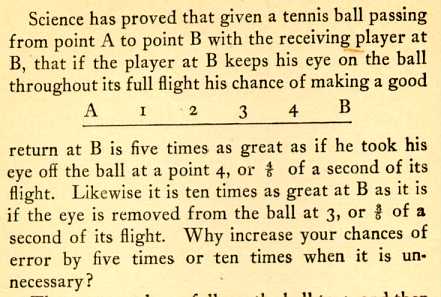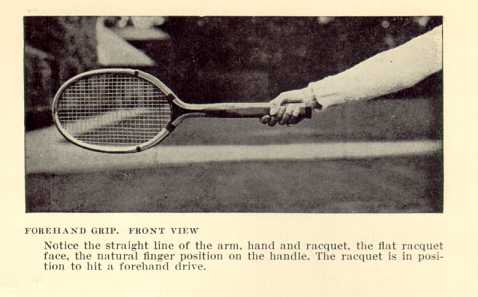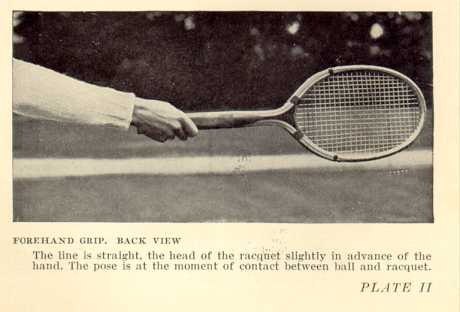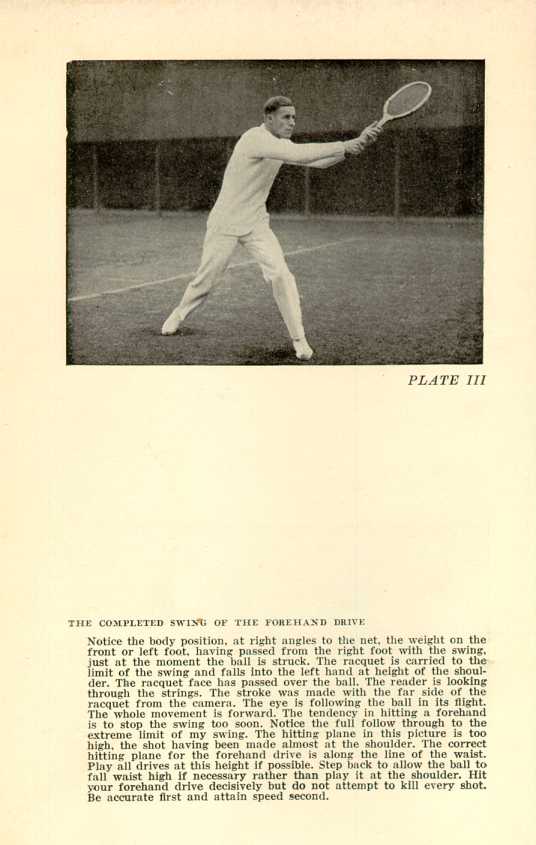| CHAPTER I FOR NOVICES ONLY The Art of Lawn Tennis | ||
1. CHAPTER I
FOR NOVICES ONLY
I TRUST this initial effort of mine in the world of letters will find a place among both novices and experts in the tennis world. I am striving to interest the student of the game by a somewhat prolonged discussion of match play, which I trust will shed a new light on the game.
May I turn to the novice at my opening and speak of certain matters which are second nature to the skilled player?
The best tennis equipment is not too good for the beginner who seeks really to succeed. It is a saving in the end, as good quality material so far outlasts poor.
Always dress in tennis clothes when engaging in tennis. White is the established colour. Soft shirt, white flannel trousers, heavy white socks, and
The question of choosing a racquet is a much more serious matter. I do not advocate forcing a certain racquet upon any player. All the standard makes are excellent. It is in weight, balance, and size of handle that the real value of a racquet frame depends, while good stringing is, essential to obtain the best results.
The average player should use a racquet that weighs between 13½ and 14½ ounces inclusive. I think that the best results may be obtained by a balance that is almost even or slightly heavy on the head. Decide your handle from the individual choice. Pick the one that fits comfortably in the hand. Do not use too small a handle or too light a racquet, as it is apt to turn in the hand. I recommend a handle of 5 1/4 to 5 3/8 inches at the grip. Do not use a racquet you do not like merely because your best friend advises it. It may suit him perfectly, but would not do for you at all. Do not start children playing tennis with an under-sized racquet. It weakens the wrist and does not aid the child in learning strokes. Start a child, boy or girl, with a full-sized racquet of at least 13 ounces.
After you have acquired your racquet, make a firm resolve to use good tennis balls, as a regular
If you really desire to succeed at the game and advance rapidly, I strongly urge you to see all the good tennis you can. Study the play of the leading players and strive to copy their strokes. Read all the tennis instruction books you can find. They are a great assistance. I shall be accused of "press-agitating" my own book by this statement, but such was my belief long before I ever thought of writing a book of my own.
More tennis can be learned off the court, in the study of theory, and in watching the best players in action, than can ever be learned in actual play. I do not mean miss opportunities to play. Far from it. Play whenever possible, but strive when playing to put in practice the theories you have read or the strokes you have watched.
Never be discouraged at slow progress. The trick over some stroke you have worked over for weeks unsuccessfully will suddenly come to you when least expected. Tennis players are the product of hard work. Very few are born geniuses at the game.
Tennis is a game that pays you dividends all your life. A tennis racquet is a letter of introduction in any town. The brotherhood of the game is universal, for none but a good sportsman can succeed in the game for any lengthy period. Tennis provides relaxation, excitement, exercise, and pure enjoyment to the man who is tied hard and fast
The tennis players of the world wrote a magnificent page in the history of the World War. No branch of sport sent more men to the colours from every country in the world than tennis, and these men returned with glory or paid the supreme sacrifice on the field of honour.
I transgressed from my opening to show you that tennis is a game worth playing and playing well. It deserves your best, and only by learning it correctly can you give that best.
If in my book I help you on your way to fame, I feel amply repaid for all the time spent in analysing the strokes and tactics I set before you in these pages.
I am going to commence my explanation by talking to the players whose games are not yet formed. At least once every season I go back to first principles to pull myself out of some rut into which carelessness dropped me.
From a long and, many times, sad experience over a period of some ten years of tournament
- 1. Concentration on the game.
- 2. Keep the eye on the ball.
- 3. Foot-work and weight-control.
- 4. Strokes.
- 5. Court position.
- 6. Court generalship or match play.
- 7. Tennis psychology.
Tennis is a game of intimate personal relation. You constantly find yourself meeting some definite idea of your opponent. The personal equation is the basis of tennis success. A great player not only knows himself, in both strength and weakness, but he must study is opponent at all times. In order to be able to do this a player must not be hampered by a glaring weakness in the fundamentals of his own game, or he will be so occupied trying to hide it that he will have no time to worry his opponent. The fundamental weakness of Gerald Patterson's backhand stroke is so apparent that any player within his class dwarfs Patterson's style by continually pounding at it. The Patterson overhead and service are first class, yet both are rendered impotent, once a man has solved the method of returning low to the backhand, for Patterson seldom succeeds in taking the offensive again in that point.
I am trying to make clear the importance of such first principles as I will now explain.
CONCENTRATION
Tennis is played primarily with the mind. The most perfect racquet technique in the world will not suffice if the directing mind is wandering. There are many causes of a wandering mind in a tennis match. The chief one is lack of interest in the game. No one should play tennis with an idea of real success unless he cares sufficiently about the game to be willing to do the drudgery necessary in learning the game correctly. Give it up at once unless you are willing to work. Conditions of play or the noises in the gallery often confuse and bewilder experienced match-players playing under new surroundings. Complete concentration on the matter in hand is the only cure for a wandering mind, and the sooner the lesson is learned the more rapid the improvement of the player. An amusing example, to all but the player affected, occurred at the finals of the Deleware State Singles Championship at Wilmington. I was playing Joseph J. Armstrong. The Championship Court borders the No. 1 hole of the famous golf course. The score stood at one set all and 3-4 and 30-40, Armstrong serving. He served a fault and started a second delivery. Just as he commenced his swing, a loud and very lusty "Fore!" rang out from the links. Armstrong unconsciously looked away and served his delivery to the backstop and the game to me. The umpire refused to "let" call and the incident closed.
The surest way to hold a match in mind is to play for every set, every game in the set, every point in the game and, finally, every shot in the point. A set is merely a conglomeration of made and missed shots, and the man who does not miss is the ultimate victor.
Please do not think I am advocating "pat-ball." I am not. I believe in playing for your shot every time you have an opening. I do not believe in trying to win the point every time you hit the ball. Never allow your concentration on any game to become so great that you do not at all times know the score and play to it. I mean both point score and game score. In my explanation of match play in a later chapter I am going into a detailed account of playing to the score. It is as vital in tennis as it is in bridge, and all bridge players know that the score is the determining factor in your mode of bidding. Let me urge again concentration. Practise seriously. Do not fool on the court, as it is the worst enemy to progress. Carelessness or laziness only results in retrogression, never progress.
Let me turn now to the first principle of all ball games, whether tennis, golf, cricket, baseball, polo, or football.
KEEP YOUR EYE ON THE BALL!
Just a few statistics to show you how vital it is that the eye must be kept on the ball until the moment of striking it.
About 85 per cent of the points in tennis are errors, and the remainder earned points. As the standard of play rises the percentage of errors drops until, in the average high-class tournament match, 60 per cent are errors and 40 per cent aces. Any average superior to this is super-tennis.
Thus the importance of getting the ball in play cannot be too greatly emphasized. Every time you put the ball back to your opponent you give him another chance to miss.
There are several causes for missing strokes. First, and by far the largest class, is not looking at the ball up to the moment of striking it. Fully 80 per cent of all errors are caused by taking the eye from the ball in the last one-fifth of a second of its flight. The remaining 20 per cent of errors are about 15 per cent bad footwork, and the other 5 per cent poor racquet work and bad bounces.
The eye is a small camera. All of us enjoy dabbling in amateur photography, and every amateur must take "action" pictures with his first camera. It is a natural desire to attain to the hardest before understanding how to reach it. The result is one of two things: either a blurred moving object and a clear background, or a clear moving object and a blurred background. Both suggest speed, but only one is a good picture of the object one attempted to photograph. In the first case the camera eye was focused on the background and not on the object, while in the second, which produced the result desired, the camera eye was firmly focused on the
Now the tennis ball is your moving object while the court, gallery, net, and your opponent constitute your background. You desire to hit the ball cleanly, therefore do not look at the other factors concerned, but concentrate solely on focusing the eye firmly on the ball, and watching it until the moment of impact with your racquet face.
"How do I know where my opponent is, or how much court I have to hit in?" ask countless beginners.
Remember this: that a tennis court is always the same size, with the net the same height and in the same relation to you at all times, so there is no need to look at it every moment or so to see if it has moved. Only an earthquake can change its position. As to your opponent, it makes little difference about his position, because it is determined by the shot you are striving to return. Where he will be I will strive to explain in my chapter on court position; but his whereabouts are known without looking at him. You are not trying to hit him. You strive to miss him. Therefore, since you must watch what you strive to hit and not follow what you only wish to miss, keep your eye on the ball, and let your opponent take care of himself.
Science has proved that given a tennis ball passing from point A to point B with the receiving player at B, that if the player at B keeps his eye on the ball throughout its full flight his chance of making a good
 [Description: Diagram of ball trajectory]
[Description: Diagram of ball trajectory]
return at B is five times as great as if he took his eye off the ball at a point 4, or 4/5 of a second of its flight. Likewise it is ten times as great at B as it is if the eye is removed from the ball at 3, or 3/5 of a second of its flight. Why increase your chances of error by five times or ten times when it is unnecessary?
The average player follows the ball to 4, and then he takes a last look at his opponent to see where he is, and by so doing increases his chance of error five times. He judges the flight of the ball some 10 feet away, and never really sees it again until he has hit it (if he does). A slight deflection caused by the wind or a small misjudgment of curve will certainly mean error. Remembering the 85 percent errors in tennis, I again ask you if it is worth while to take the risk?
There are many other reasons why keeping the eye on the ball is a great aid to the player. It tends to hold his attention so that outside occurrences will not distract. Movements in the gallery are not seen, and stray dogs, that seem to particularly enjoy sleeping in the middle of a tennis court during a hard match, are not seen on their way to their sleeping quarters. Having learned the knack of watching
the ball at all times, I felt that nothing would worry me, until three years ago at the American Championships, when I was playing T. R. Pell. A press-camera man eluded the watchful eye of the officials, and unobtrusively seated himself close to our sideline to acquire some action pictures. Pell angled sharply by to my backhand, and I ran at my hardest for the shot, eyes fixed solely on the ball. I hauled off to hit it a mighty drive, which would have probably gone over the backstop, when suddenly I heard a camera click just under me, and the next moment camera, pressman, and tennis player were rolling in a heap all over the court. The pressman got his action picture and a sore foot where I walked on him, and all I got was a sore arm and a ruffled temper. That's why I don't like cameras right under my nose when I play matches, but for all that I still advocate keeping your eye on the ball.
GRIP, FOOTWORK, AND STROKES
Footwork is weight control. It is correct body position for strokes, and out of it all strokes should grow. In explaining the various forms of stroke and footwork I am writing as a right-hand player. Left-handers should simply reverse the feet.
Racquet grip is a very essential part of stroke, because a faulty grip will ruin the finest serving. There is the so-called Western or Californian grip as typified by Maurice E. M`Loughlin, Willis, E. Davis, and, to a slightly modified degree, W. M.
The English grip, with the low wrist on all ground strokes, has proved very successful in the past. Yet the broken line of the arm and hand does not commend itself to me, as any broken line is weak under stress.
The Eastern American grip, which I advocate, is the English grip without the low wrist and broken line. To acquire the forehand grip, hold the racquet with the edge of the frame towards the ground and the face perpendicular, the handle towards the body, and "shake hands" with it, just as if you were greeting a friend. The handle settled comfortably and naturally into the hand, the line of the arm, hand, and racquet are one. The swing brings the racquet head on a line with the arm, and the whole racquet is merely an extension of it.
The backhand grip is a quarter circle turn of hand on the handle, bringing the hand on top of the handle and the knuckles directly up. The shot travels across the wrist.
This is the best basis for a grip. I do not advocate learning this grip exactly, but model your natural grip as closely as possible on these lines without sacrificing your own comfort or individuality.
Having once settled the racquet in the hand, the next question is the position of the body and the order of developing strokes.
In explaining footwork I am, in future, going to refer in all forehand shots to the right foot as R or "back" foot, and to the left as L or "front." For the backhand the L foot is "back" and R is "front."
All tennis strokes, should be made with the body' at right angles to the net, with the shoulders lined up parallel to the line of flight of the ball. The weight should always travel forward. It should pass from the back foot to the front foot at the moment of striking the ball. Never allow the weight to be going away from the stroke. It is weight that determines the "pace" of a stroke; swing that, decides the "speed."
Let me explain the definitions of "speed" and "pace." "Speed" is the actual rate with which a ball travels through the air. "Pace" is the momentum with which it comes off the ground. Pace is weight. It is the "sting" the ball carries when it comes off the ground, giving the inexperienced or unsuspecting player a shock of force which the stroke in no way showed.
Notable examples of "pace" are such men as W. A. Larned, A. W. Gore, J. C. Parke, and among the younger players, R. N. Williams, Major A. R. F. Kingscote, W. M. Johnston, and, on his forehand stroke, Charles S. Garland.
M. E. M`Loughlin, Willis E. Davis, Harold Throckmorton and several others are famous "speed" exponents.
A great many players have both "speed" and "pace." Some shots may carry both.
The order of learning strokes should be:
- 1. The Drive. Fore-and backhand. This is the foundation of all tennis, for you cannot build up a net attack unless you have the ground stroke to open the way. Nor can you meet a net attack successfully unless you can drive, as that is the only successful passing shot.
- 2. The Service.
- 3. The Volley and Overhead Smash.
- 4. The Chop or Half Volley and other incidental and ornamental strokes.
| CHAPTER I FOR NOVICES ONLY The Art of Lawn Tennis | ||


